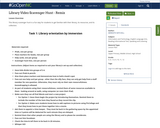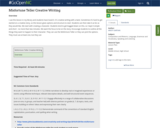
The focus of this lesson is Hughes' use of stair as a symbol for life.
- Subject:
- Reading Literature
- Speaking and Listening
- Material Type:
- Lesson Plan
- Author:
- STEPHANIE HUTCHINSON
- Date Added:
- 11/12/2019

The focus of this lesson is Hughes' use of stair as a symbol for life.

In this lesson, students will continue to explore the relationship between individual and society by examining how we so often believe “single stories” and stereotypes about groups of people. The activities that follow ask students to reflect on the basic human behavior of applying categories to the people and things we meet and to think about the circumstances in which “single stories” about others can be harmful or even dangerous.

This library scavenger hunt is a fun way for students to get familiar with their library, its resources, and its collection.

This library scavenger hunt is a fun way for students to get familiar with their library, its resources, and its collection.

Upon completion of genre study on poetry, students will create their own limerick. While reading poems in their Wonders Literature Anthology and Student Reading / Writing Companion, students will learn about inventions through various poem structures. Students will be provided with a list of inventors to research, selecting an invention to create their own limerick while using “Cold Feet”, “Our Washing Machine” and “Bugged” (p.166) as a model. Students must include poetry elements such as metaphors / similes, alliteration and rhyming words in their written poem. Students will record themselves reading their poem using their Chromebook, upload their video into Google Slides and include a photo representation of the invention.

The first step in cybersecurity is learning how to log out of a Chromebook! This lesson teaches students what cybersecurity it, the importance of cybersecurity, and how they can engage in cybersecurity by logging out of their Chromebooks correctly.
It includes an anchor chart, slides, and a Breakout game to test their cyber security knowledge!

I use this lesson in my library and students have loved it. It's creative writing with a twist. Sometimes it's hard to get started on a creative story, so this lesson gives options and structure to start. Students can then take it as far as they would like. We start with creating a character. Students tend to get bogged down on this, so I kept it simple and short - no more than two minutes. We want the focus to be on the story. Encourage students to outline all the things they want to happen to their character. They can use the Misfortune Teller or they can pick the options. They must use at least one, but they can

This is a template to help guide integration of music and literacy. It includes a checklist of musical elements to consider when choosing a book for any subject class, a list of cross-curricular applications, enrichment activities, and student learning assessment. Immediately following the template is an example of a book, the musical elements, cross-curricular applications, enrichment activities, and assessments.
This template is recommended for music teachers looking to enhance literacy in music classes, and for other subject teachers who want to use music to enhance literacy.

Christine D'Aquanni with Be GLAD® presented strategies at ASCD Annual Conference 2021 in a session called Be GLAD®: Strategies for Creating a Community of Collaborative Learners. The Narrative Input Chart is one strategy for making content comprehensible, particularly to support English Learners reading to understand sequence of events with key details. These slides were created as just one resource to support a reading of The Water Princess by Susan Verde and Peter H. Reynolds.

Rubric for use with oral presentations--works for multiple grades.

This is an activity to check for understanding of the concept of story elements. Do the students know and understand the terms? Can he or she determine the story elements of a particular story?

Student choice board ELA. Adaptable for any unit/topic.

The first day of the school it is the key for the students to feel welcome to their classes and to your class, We need to know how to make them confortable working with you and if you know them well they will like you as their teacher

The first day and week of school is key for students to feel welcome in their classes and to your class. The activities planned from the first day onward are integral in making connections. This initial assignment is designed to help students in your class explore their voice, ability, and personal identity.

Utilize these questions with literature recommended for bibliotherapy use with gifted students.

Students will build background and show understanding about government elections at the local, state, and national levels in the United States.
Students will write, revise, and edit an informational piece to demonstrate mastery of the topic of elections incorporating key academic content vocabulary.
Students will create a PPT with a teacher's model to demonstrate understanding and mastery of key content area vocabulary words.
Students will complete activities during independent work time or literacy stations. Provides a QR code for students to listen to stories (2 non-fiction and 1 fiction) about elections. After they listen to the stories they choose one of the non-fiction texts to write facts about, find the main idea and key details, and define new words

Lesson covers several kinds of figurative language, especially omission.

Utilize these questions with literature recommended for bibliotherapy use with gifted students. This is a remix of "Bibliotherapy Questions for Gifted Students created by DANNEY DAILEY II.
In the remix, two thinking routines have been added to support the questions.

This unit was created by the Rethink Education Content Development Team. This course is aligned to the NC Standards for 1st Grade ELA.

This unit was created by the Rethink Education Content Development Team. This unit is aligned to the NC Standards for 2nd Grade ELA.